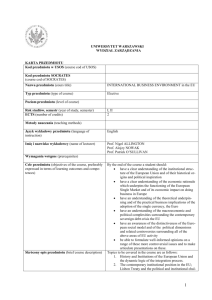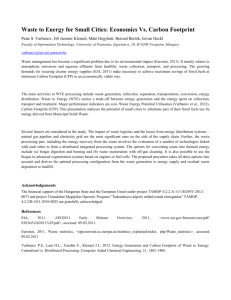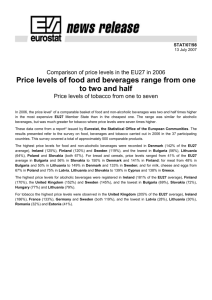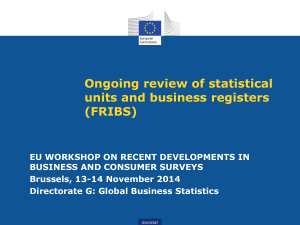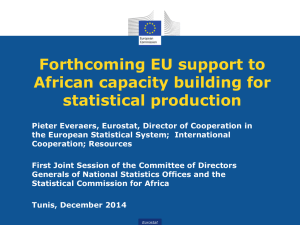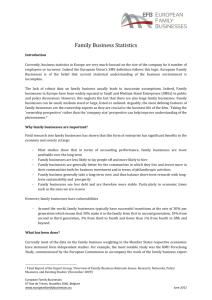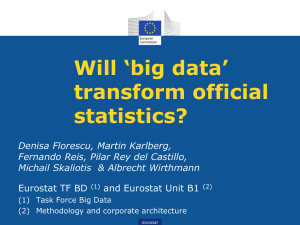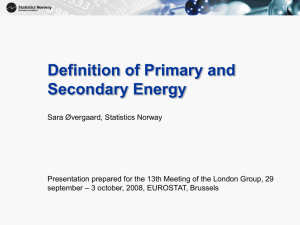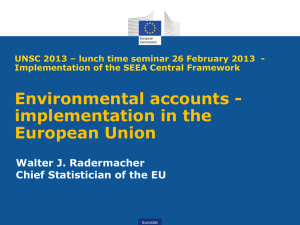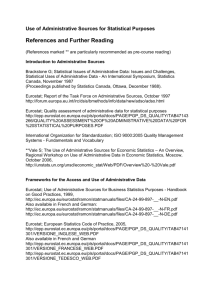Resource productivity in the EU up by 28% in 2014
advertisement
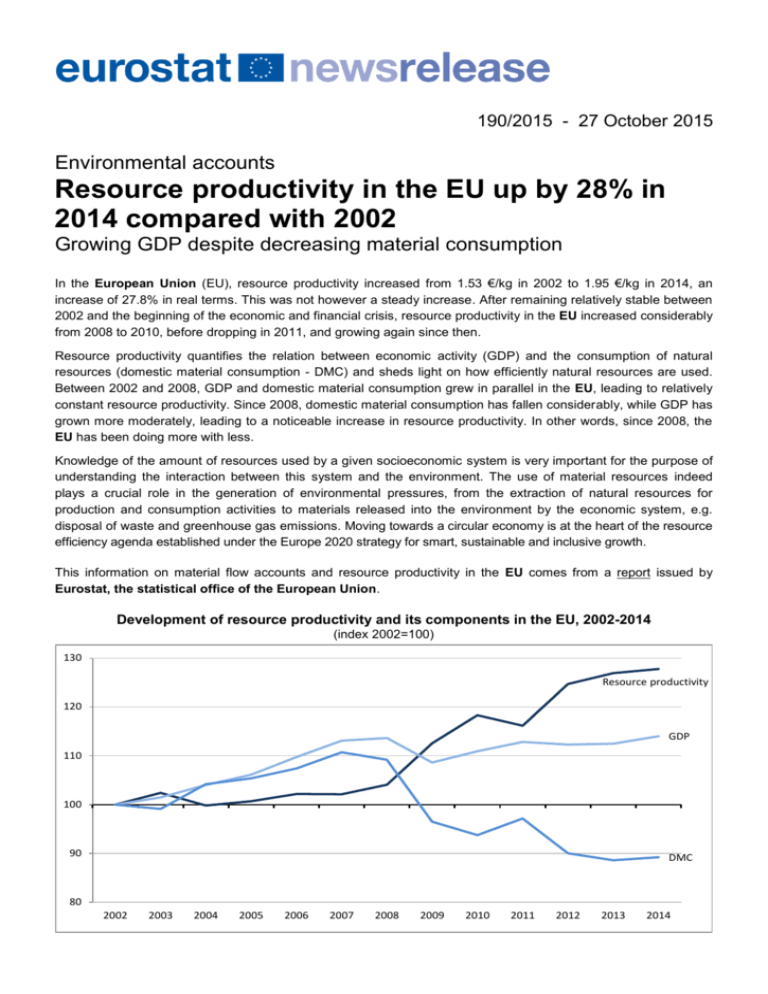
190/2015 - 27 October 2015 Environmental accounts Resource productivity in the EU up by 28% in 2014 compared with 2002 Growing GDP despite decreasing material consumption In the European Union (EU), resource productivity increased from 1.53 €/kg in 2002 to 1.95 €/kg in 2014, an increase of 27.8% in real terms. This was not however a steady increase. After remaining relatively stable between 2002 and the beginning of the economic and financial crisis, resource productivity in the EU increased considerably from 2008 to 2010, before dropping in 2011, and growing again since then. Resource productivity quantifies the relation between economic activity (GDP) and the consumption of natural resources (domestic material consumption - DMC) and sheds light on how efficiently natural resources are used. Between 2002 and 2008, GDP and domestic material consumption grew in parallel in the EU, leading to relatively constant resource productivity. Since 2008, domestic material consumption has fallen considerably, while GDP has grown more moderately, leading to a noticeable increase in resource productivity. In other words, since 2008, the EU has been doing more with less. Knowledge of the amount of resources used by a given socioeconomic system is very important for the purpose of understanding the interaction between this system and the environment. The use of material resources indeed plays a crucial role in the generation of environmental pressures, from the extraction of natural resources for production and consumption activities to materials released into the environment by the economic system, e.g. disposal of waste and greenhouse gas emissions. Moving towards a circular economy is at the heart of the resource efficiency agenda established under the Europe 2020 strategy for smart, sustainable and inclusive growth. This information on material flow accounts and resource productivity in the EU comes from a report issued by Eurostat, the statistical office of the European Union. Development of resource productivity and its components in the EU, 2002-2014 (index 2002=100) 130 Resource productivity 120 GDP 110 100 90 DMC 80 2002 2003 2004 2005 2006 2007 2008 2009 2010 2011 2012 2013 2014 Resource productivity highest in Luxembourg, the Netherlands and the United Kingdom The level of resource productivity varies widely between the EU Member States, depending on countries' natural endowments, the diversity of their industrial activities, the role played by the services sector and by construction activities, the scale and patterns of consumption and the different energy sources. In 2014, the highest resource productivity was recorded in Luxembourg (3.94 €/kg), followed by the Netherlands (3.82 €/kg), the United Kingdom (3.28 €/kg), Italy (2.89 €/kg), Spain (2.69 €/kg) and France (2.60 €/kg). At the opposite end of the scale, seven Member States registered resource productivity lower than 1 €/kg: Bulgaria (0.30 €/kg), Romania (0.32 €/kg), Estonia (0.42 €/kg), Latvia (0.49 €/kg), Poland (0.61 €/kg), Lithuania (0.65 €/kg) and Hungary (0.89 €/kg). Resource productivity in the EU Member States, 2014 (in €/kg) 4 3 2 1 0 Largest growth in resource productivity in Spain and Ireland Compared with 2002, most of the EU Member States have seen their resource productivity in 2014 rise, with the highest increases being observed in Spain (+123.9%), Ireland (+96.7%), Slovenia (+67.6%), Slovakia (+60.6%), Cyprus (+57.8%) and Italy (+56.9%). In contrast, decreases were recorded in Estonia (-19.7%), Malta (-18.6%), Romania (-8.3%), Sweden (-2.1%) and Lithuania (-1.1%). Resource productivity mainly driven by a fall in DMC in most Member States An analysis of the resource productivity components helps to explain these developments. Overall across Member States, the increase in resource productivity from 2002 to 2014 has been mainly driven by a fall in domestic material consumption. The Member States recording the highest increases in resource productivity were generally also those where domestic material consumption decreased the most. This was particularly the case for Spain (DMC halved between 2002 and 2014), Italy (-38.4%) and Ireland (-33.2%). Only in Bulgaria, Latvia and Poland did resource productivity improve despite a significant increase in domestic material consumption as in these three Member States, GDP grew even faster. Conversely, in all Member States where resource productivity decreased between 2002 and 2014, domestic material consumption significantly increased over the same period, notably in Estonia (DMC has grown by 80.6% between 2002 and 2014), Romania (+62.3%), Malta (+61.4%), Lithuania (+59.8%) and Sweden (+28.7%). Resource efficiency in the EU Member States, 2014 Resource productivity (in €/kg) Domestic material consumption (in million tonnes) Change 2014/2002 (%) 2014 Change 2014/2002 (%) 2014 EU 1.95 27.8 6 746.5 Belgium 2.39 14.9 Bulgaria 0.30 21.1 Czech Republic 1.00 45.1 Denmark 2.10 Germany 2.09 Estonia 0.42 Ireland 1.49 Greece Spain Gross domestic product (in billion €) Change 2014/2002 (%) 2014 -10.8 13 150.5 14.0 157.8 2.7 377.3 18.1 133.0 20.9 39.5 46.3 160.0 -7.8 160.3 33.8 8.5 116.1 -1.5 244.1 6.9 16.1 1 309.5 -1.8 2 736.4 14.1 -19.7 41.2 80.6 17.4 45.0 96.7 122.5 -33.2 182.2 31.4 1.39 13.3 133.2 -20.3 185.5 -9.7 2.69 123.9 386.6 -50.0 1 038.6 11.8 France 2.60 21.8 792.4 -7.4 2 060.9 12.8 Croatia 1.09 34.6 39.7 -16.2 43.3 12.7 Italy 2.89 56.9 532.1 -38.4 1 535.3 -3.3 Cyprus 1.31 57.8 13.2 -28.2 17.2 13.8 Latvia 0.49 24.2 42.9 19.8 20.8 48.8 Lithuania 0.65 -1.1 50.4 59.8 32.9 58.0 Luxembourg 3.94 30.1 11.1 4.8 43.7 36.3 Hungary 0.89 38.1 116.3 -13.9 103.8 18.9 Malta 1.34 -18.6 5.5 61.4 7.3 31.4 Netherlands 3.82 23.0 167.0 -8.5 638.5 12.6 Austria 1.71 26.0 179.7 -6.7 307.3 17.5 Poland 0.61 18.9 659.0 33.2 403.7 58.4 Portugal 1.15 36.6 147.5 -27.9 169.1 -1.5 Romania 0.32 -8.3 425.7 62.3 137.2 48.8 Slovenia 1.43 67.6 25.3 -27.6 36.2 21.4 Slovakia 1.20 60.6 60.9 0.7 73.2 61.7 Finland 1.00 8.6 185.7 4.0 186.3 13.0 Sweden 1.72 -2.1 228.1 28.7 391.4 26.0 United Kingdom 3.28 49.5 600.5 -19.3 1 967.5 20.7 Methods and definitions This News Release uses data from the Eurostat economy-wide material flow accounts (EW-MFA), which are one of the European environmental economic accounts. Environmental accounts analyse the interaction between the environment and the economy by organising environmental information in a way that is consistent with the accounting principles of national accounts. This enables investigating many questions, for example: which activities are the most polluting; the implications of resource use for development and the environment; the role of government and households; how expensive is it to protect the environment and who pays for it; how large is the environmental economy in terms of employment or output; how large are the flows of natural resources and energy. The methodology of European environmental accounts is in line with the system of integrated environmental and economic accounting (SEEA), which is an international statistical standard. Resource productivity is defined as the ratio of GDP (in chain-linked volumes) to domestic material consumption (DMC). The indicator is expressed in € per kg. Domestic material consumption measures the total amount of material directly used by an economy, such as biomass products, metal ores, fossil fuels and non-metallic minerals and is equal to domestic material extraction plus physical imports minus physical exports. This indicator is expressed in tonnes per year. For more information A resource-efficient Europe is one of the flagship initiatives of the Europe 2020 strategy: it supports the shift towards a resourceefficient, low-carbon economy to achieve sustainable growth. Eurostat resource efficiency scoreboard. Eurostat website section dedicated to material flows and resource productivity. Eurostat metadata on material flow accounts. Eurostat Statistics Explained articles on material flow accounts and resource productivity, resource productivity statistics and physical imports and exports. Issued by: Eurostat Press Office Production of data: Vincent BOURGEAIS Tel: +352-4301-33 444 eurostat-pressoffice@ec.europa.eu Renato MARRA CAMPANALE Tel: +352-4301-36 995 renato.marra-campanale@ec.europa.eu ec.europa.eu/eurostat @EU_Eurostat Media requests: Eurostat media support / Tel: +352-4301-33 408 / eurostat-mediasupport@ec.europa.eu

